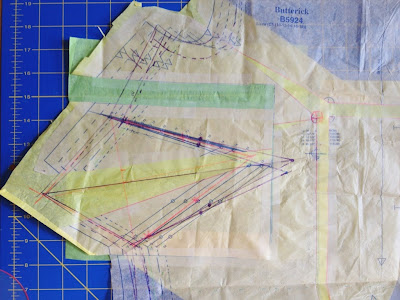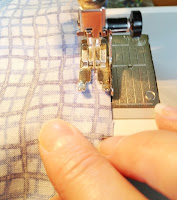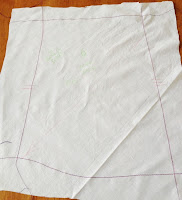In a couple of the last few blogs that I have done, I gave a how-to on making bias binding and cross grain binding. Regardless of which kind of binding you have made, you have to get it on the quilt.
 Now, having done yards and yards of binding over the years with this machine, I know just where to sew to get the width that I always use. You may have to practice a bit to get it just right. The type of batting and "hand" the fabric has also affects where you sew the binding, too. I know the few times that I have used a different fabric or batting, I have had to adjust either the position of the needle or where the raw edges line up in my machine.
Now, having done yards and yards of binding over the years with this machine, I know just where to sew to get the width that I always use. You may have to practice a bit to get it just right. The type of batting and "hand" the fabric has also affects where you sew the binding, too. I know the few times that I have used a different fabric or batting, I have had to adjust either the position of the needle or where the raw edges line up in my machine.Applying the binding is easy on the straight of way. Begin in the center of one side of the quilt. All you do is keep the fabric straight and let the machine do the work. The hard part for me is sewing the corners. I place a pin 3/8 inches before the end of
the fabric and sew until I hit this mark and backstitch a few stitches. This makes sure that the corner will be easier to hand sew later.
You have to remove the quilt from the machine at this point -- each side of the quilt is sewn separately. And the sides start and end at the corner.
 To get a great sharp corner, don't rush through these steps. First fold the binding up creating a triangle and let the leading end of the binding flip back over the side you just completed.
To get a great sharp corner, don't rush through these steps. First fold the binding up creating a triangle and let the leading end of the binding flip back over the side you just completed.
Then fold the fabric back on itself.
 At this point there will be a small triangle of binding that will flip off the corner of the quilt.
At this point there will be a small triangle of binding that will flip off the corner of the quilt.Again, place a pin at the 3/8 inch from the raw edges at the top and begin sewing here. If you have been careful, you won't have sewn past the 3/8 inch mark and will get a really great corner.
Continue to sew all of the remaining sides and corners until you get back to the side that you started the binding. You will want to stop sewing about 8 to 10 inches before your starting point. And trim the binding off at a 45 degree angle about half way between the start and finish of the sewing.
Open both ends of the binding and overlap the just cut end over the beginning end. On the wrong side of the fabric use a pen to mark where the binding hits.
 Make sure that the line is at a 45° angle -- you can see that I have lined up the edge of the binding with the 45° angle on my ruler -- and draw the line even darker. and all the way across.
Make sure that the line is at a 45° angle -- you can see that I have lined up the edge of the binding with the 45° angle on my ruler -- and draw the line even darker. and all the way across.Now thing carefully before this next step. You are going to line up your just marked line on the 1/2 inch line of your ruler. The end of the fabric will be where you are going to cut.
CAREFUL! If you are on the other side, you will cut your binding 1/2 inch too short. I tell you this from experience as I have had to add extra binding and redo the cut more times than I care to admit!!
Pin the two ends together so that the little "dog ears" are a 1/4 inch wide. Then sew the binding together with a quarter inch seam. You can finger press the seam to the side and stretch out the fabric and press it with an iron to get a nice crease.
Then sew up that last little opening.
Next up hand finishing!
Happy binding!
















































